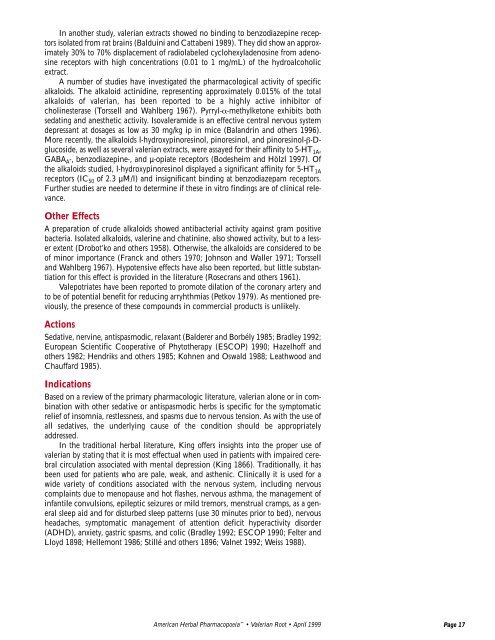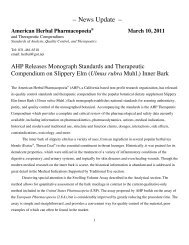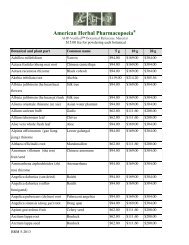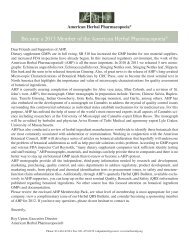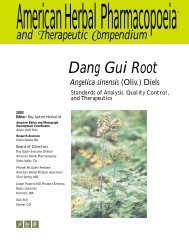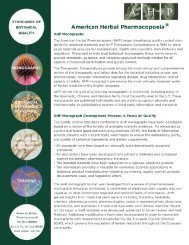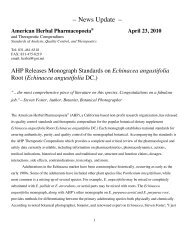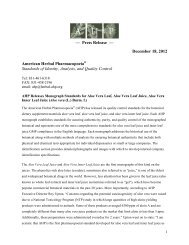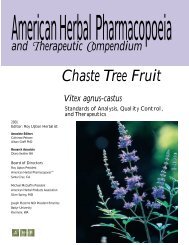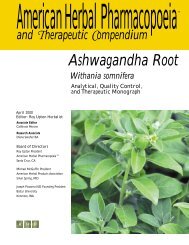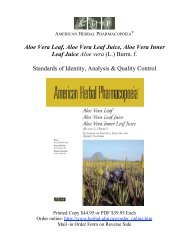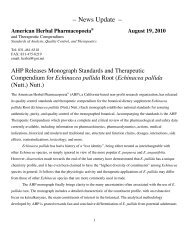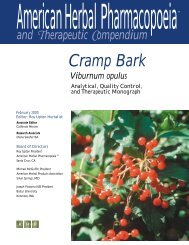alerian oot - American Herbal Pharmacopoeia
alerian oot - American Herbal Pharmacopoeia
alerian oot - American Herbal Pharmacopoeia
You also want an ePaper? Increase the reach of your titles
YUMPU automatically turns print PDFs into web optimized ePapers that Google loves.
In another study, v<strong>alerian</strong> extracts showed no binding to benzodiazepine receptors<br />
isolated from rat brains (Balduini and Cattabeni 1989). They did show an approximately<br />
30% to 70% displacement of radiolabeled cyclohexyladenosine from adenosine<br />
receptors with high concentrations (0.01 to 1 mg/mL) of the hydroalcoholic<br />
extract.<br />
A number of studies have investigated the pharmacological activity of specific<br />
alkaloids. The alkaloid actinidine, representing approximately 0.015% of the total<br />
alkaloids of v<strong>alerian</strong>, has been reported to be a highly active inhibitor of<br />
cholinesterase (Torssell and Wahlberg 1967). Pyrryl-α-methylketone exhibits both<br />
sedating and anesthetic activity. Isovaleramide is an effective central nervous system<br />
depressant at dosages as low as 30 mg/kg ip in mice (Balandrin and others 1996).<br />
More recently, the alkaloids l-hydroxypinoresinol, pinoresinol, and pinoresinol-β-Dglucoside,<br />
as well as several v<strong>alerian</strong> extracts, were assayed for their affinity to 5-HT 1A,<br />
GABA A-, benzodiazepine-, and µ-opiate receptors (Bodesheim and Hölzl 1997). Of<br />
the alkaloids studied, l-hydroxypinoresinol displayed a significant affinity for 5-HT 1A<br />
receptors (IC 50 of 2.3 µM/l) and insignificant binding at benzodiazepam receptors.<br />
Further studies are needed to determine if these in vitro findings are of clinical relevance.<br />
Other Effects<br />
A preparation of crude alkaloids showed antibacterial activity against gram positive<br />
bacteria. Isolated alkaloids, valerine and chatinine, also showed activity, but to a lesser<br />
extent (Drobot’ko and others 1958). Otherwise, the alkaloids are considered to be<br />
of minor importance (Franck and others 1970; Johnson and Waller 1971; Torssell<br />
and Wahlberg 1967). Hypotensive effects have also been reported, but little substantiation<br />
for this effect is provided in the literature (Rosecrans and others 1961).<br />
Valepotriates have been reported to promote dilation of the coronary artery and<br />
to be of potential benefit for reducing arryhthmias (Petkov 1979). As mentioned previously,<br />
the presence of these compounds in commercial products is unlikely.<br />
Actions<br />
Sedative, nervine, antispasmodic, relaxant (Balderer and Borbély 1985; Bradley 1992;<br />
European Scientific Cooperative of Phytotherapy (ESCOP) 1990; Hazelhoff and<br />
others 1982; Hendriks and others 1985; Kohnen and Oswald 1988; Leathwood and<br />
Chauffard 1985).<br />
Indications<br />
Based on a review of the primary pharmacologic literature, v<strong>alerian</strong> alone or in combination<br />
with other sedative or antispasmodic herbs is specific for the symptomatic<br />
relief of insomnia, restlessness, and spasms due to nervous tension. As with the use of<br />
all sedatives, the underlying cause of the condition should be appropriately<br />
addressed.<br />
In the traditional herbal literature, King offers insights into the proper use of<br />
v<strong>alerian</strong> by stating that it is most effectual when used in patients with impaired cerebral<br />
circulation associated with mental depression (King 1866). Traditionally, it has<br />
been used for patients who are pale, weak, and asthenic. Clinically it is used for a<br />
wide variety of conditions associated with the nervous system, including nervous<br />
complaints due to menopause and hot flashes, nervous asthma, the management of<br />
infantile convulsions, epileptic seizures or mild tremors, menstrual cramps, as a general<br />
sleep aid and for disturbed sleep patterns (use 30 minutes prior to bed), nervous<br />
headaches, symptomatic management of attention deficit hyperactivity disorder<br />
(ADHD), anxiety, gastric spasms, and colic (Bradley 1992; ESCOP 1990; Felter and<br />
Lloyd 1898; Hellemont 1986; Stillé and others 1896; Valnet 1992; Weiss 1988).<br />
<strong>American</strong> <strong>Herbal</strong> <strong>Pharmacopoeia</strong> • V<strong>alerian</strong> R<strong>oot</strong> • April 1999 Page 17


